Nappy Goo
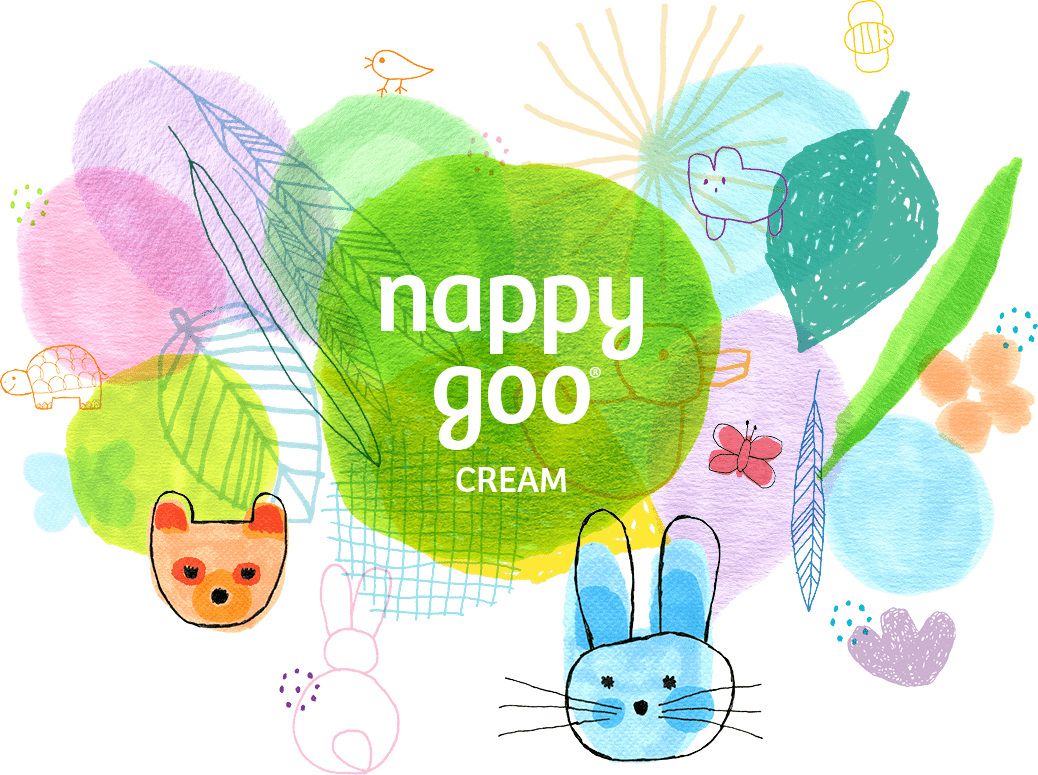

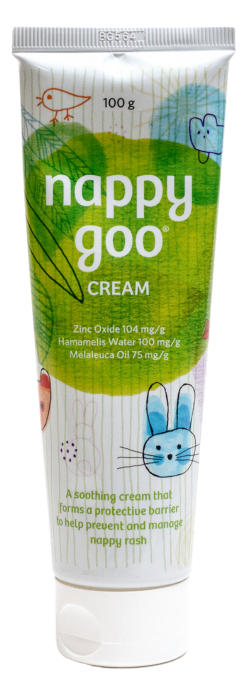
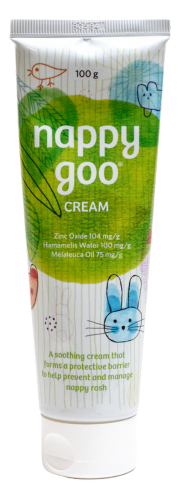
About Nappy Goo®
Developed and manufactured in Melbourne, Australia, Nappy Goo is a soothing cream that forms a protective barrier to prevent and manage nappy rash.
How to use Nappy Goo
Apply a thin layer of cream to the nappy area with each nappy change, as required. Ensure your babys’ bottom is clean before applying Nappy Goo. The cream does not need to be completely removed during nappy changes.
Nappy Goo ingredients
The active ingredients in Nappy Goo cream are:
- Zinc oxide
- Hamamelis water
- Melaleuca oil
The non-active ingredients in Nappy Goo cream are calcium hydroxide, oleic acid, olive oil, purified water and wool fat (lanolin).
For the Nappy Goo Safety Data Sheet (SDS) click SDS Nappy Goo cream
*Always read the label. Use only as directed. For topical use only. Avoid eyes. If symptoms persist, seek the advice of a healthcare professional.

About nappy rash
Nappy rash is irritation of the skin surrounding the ‘nappy area’. It can be quite sore and uncomfortable for your baby or toddler, especially when urine or faeces come into contact with the affected area. It is a common problem in babies and toddlers who wear nappies, but is usually not a sign of anything serious.
Signs and symptoms of nappy rash
If your baby has nappy rash, the skin under the nappy will look red and inflamed and can sometimes be spotty in appearance, particularly near the edges of the rash. The folds of the skin are not usually affected. The skin may blister and peel, leaving raw patches. Your baby may be unusually irritable or unsettled as nappy rash can be quite sore and uncomfortable, especially when urine comes into contact with the rash. If mild nappy rash is left untreated, it can develop into something more serious, such as a yeast or bacterial skin infection.
Causes of nappy rash
Nappy rash starts with an impairment of the skin’s natural barrier function from being covered by a nappy. Prolonged exposure to moisture is the main factor contributing to nappy rash. The longer the nappy is wet or dirty, the greater the risk of developing nappy rash. Factors that may contribute to the development of nappy rash, include:
- Friction with the nappy on soft skin
- Exposure to urine and faeces
- Infrequent nappy changes
- Change in diet
- Diarrhoea
- Antibiotic therapy
- Use of irritating cleansing agents such as soap and detergents
- Cloth nappies and plastic pants
- Existing skin conditions and sensitive skin
How to prevent and manage nappy rash
It is important to remember that nappy rash is a common condition and that most babies will experience nappy rash at some stage, no matter how well they are looked after. If nappy rash does occur, it can usually be managed easily and effectively, however it is always better to prevent nappy rash from developing.
A few things you can do to help prevent and manage nappy rash:
- Apply a layer of barrier cream, such as Nappy Goo, at each nappy change to prevent moisture and irritants from reaching the skin.
- A good quality disposable nappy will ensure the moisture is absorbed quickly and the skin is kept dry. Nappy rash is less common with disposable nappies compared with cloth nappies.
- Frequent nappy changes to reduce the amount of time that urine and faeces are in contact with the skin. Change the nappy immediately after a poo.
A few things you can do to help prevent and manage nappy rash:
- Reduce the use of baby wipes as these can be irritating to the skin. Use cotton wool or a soft cloth dampened with luke-warm water. If baby wipes are necessary, use good quality wipes that are free from perfume and alcohol.
- Use a soap alternative, such as soap free bath oil or wash, to reduce further irritation to the affected area. Gently clean the skin. Avoid excessive cleaning as this can irritate the skin and make the nappy rash worse.
- Allow baby to have as much ‘nappy free’ time as practical.
- If the rash does not respond to a barrier cream, or worsens, seek the advice of a healthcare professional.
For more information about nappy rash, speak to your local doctor, community pharmacist or maternal child health nurse.
*Always read the label. Use only as directed. If symptoms persist, seek the advice of a healthcare professional.
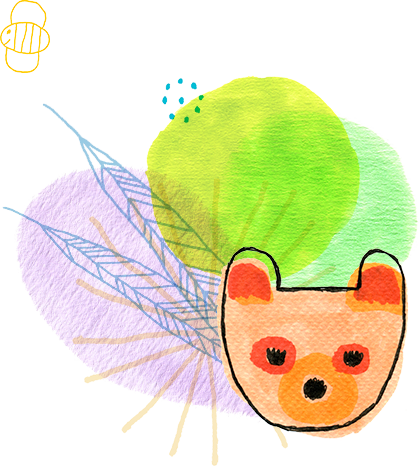
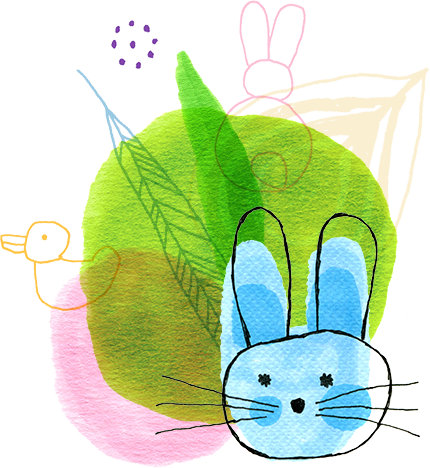
FAQs
1. What is nappy rash?
Nappy rash is irritation of the skin surrounding the ‘nappy area’. It is a common problem in babies and toddlers who wear nappies, but is usually not a sign of anything serious.
2. How do I know if my child has nappy rash?
If your baby has nappy rash, the skin under the nappy will look red and inflamed and can sometimes be spotty in appearance. The skin may blister and peel, leaving raw patches. Your baby may be unusually irritable or unsettled as nappy rash can be quite sore and uncomfortable, especially when urine comes into contact with the rash.
3. How can I prevent and manage nappy rash?
The first step in both the prevention and management of nappy rash is to apply a barrier cream, such as Nappy Goo, at each nappy change to prevent moisture and irritants from reaching the skin. For more helpful tips on how to prevent and manage nappy rash, see our Nappy Rash information.
4. How often should I apply Nappy Goo?
Apply a layer of Nappy Goo at each nappy change to help prevent and manage nappy rash.
5. Can I use Nappy Goo on my child if they don’t have nappy rash?
Absolutely. Nappy Goo is a soothing cream that helps to prevent nappy rash from developing, and is gentle enough to apply with each nappy change.
6. When should I seek further medical advice for my child’s nappy rash?
If the rash does not respond to treatment with Nappy Goo within a few days, or if symptoms worsen, seek the advice of a healthcare professional.
7. Are there other uses for Nappy Goo?
Nappy Goo can also be used by cyclists, gardeners and the elderly to help prevent chafing or rashes around the ‘underwear area’.
8. My child has sensitive skin, can I use Nappy Goo?
If your child has sensitive skin, always remember to do a patch test first on an unaffected area of skin.
9. Nappy Goo is causing irritation to the skin. What should I do?
If irritation occurs, discontinue use and seek the advice of a healthcare professional.
10. What ingredients are in Nappy Goo?
Zinc oxide, hamamelis water (witch hazel water), melaleuca oil (tea tree oil), calcium hydroxide, oleic acid, olive oil, purified water, wool fat (lanolin).
11. Where is Nappy Goo made?
Nappy Goo is proudly made in Melbourne, Australia.
12. Where can I buy Nappy Goo?
Nappy Goo is available from all good pharmacies, baby shops and online stores.
*Always read the label. Use only as directed. If symptoms persist, see your healthcare professional.
Nappy Goo stockists
If you’d like to become a Nappy Goo stockist, please do not hesitate to reach out via email for more information.
*Always read the label. Use only as directed. If symptoms persist, seek the advice of a healthcare professional.
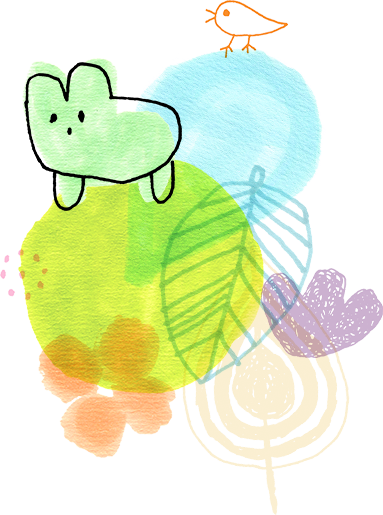
Contact us

For further details regarding Nappy Goo or to become a stockist, please contact us:
Telephone 03 9345 5995 or Email
Nappy Goo® is a registered trademark of The Royal Children’s Hospital Melbourne.
*Always read the label. Use only as directed. If symptoms persist, see your healthcare professional.
All content © Nappy Goo 2023. Login
